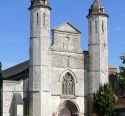Throughout the churches of Auchy-lès-Hesdin
Description of the route:
When leaving the abbey church of Auchy-lès-Hesdin, take the direction of Rollancourt. At the end of the city, take the GR de Pays de Ternois sud and cross the Bois de Rollancourt. Arrived in Blingel, take the direction of Blangy-sur-Ternoise. After visiting the church, take the D104 towards Humeroeuille. At the exit of Blangy, take the field track on your right up to Eclimeux. From there, take the Chemin d'Incourt, then the D107, then the D 109 (be careful when crossing the National 39!). Cross Le Fresnoy and visit the church of Vieil-Hesdin. Take the direction of Parcq, then return to Auchy-lès-Hesdin.
-
Abbey church of Saint-Georges and Saint-Silvain, Auchy-lès-Hesdin
The name "Auchy-lès-Hesdin" has only existed for two hundred years. The village was named Alciacus at the time of the existence of a monastery of nuns (670-871). Saint Sylvin lived and died there in 718. Several appellations followed one another before "Auchy-les-Moines" in the 17th century, due to the presence of an abbey of Benedictine monks (1072-1791). The abbey gave way to a cotton mill in the 19th and 20th centuries. The abbey church became the parish church. It attracts attention by its facade with two octagonal towers dating from the 13th century, rare in the Pas-de-Calais region. Higher and longer in the Middle Ages, this building was redesigned in the 17th century after having suffered much from the battles in the region in the 15th and 16th centuries, against the English (Azincourt is very close), then from the wars against the Holy Roman Empire (marked by the destruction of Therouanne and the neighbouring city of Hesdin in 1553). On the facade, a classical pediment was added between the two towers in 1840, but medieval elements and the ogival style of the building have been preserved. The main nave, whose lower parts date from the 13th century, is very characteristic of an abbey church, as well as the important set of beautiful late 17th / early 18th century stalls, where the monks stood during the services and which is maintained in its original location.
-
Blangy
In 682, Blangy opened an abbey founded by Sainte-Berthe, born on the village land in 644, where Berthe had previously married Sigefroy, Baron of Auxi-le-Château, and gave him five daughters, three of whom survived: Gertrude, Déotile and Emme. Now a widow, Berthe founded an abbey and retired there with his two eldest daughters. Berthe lived there in renunciation and healed Ruodgaire, an officer of King Thierry III of the Franks, who became blind after slandering the abbess. She died in 723, Her daughters Déotile, then Gertrude, succeeded her as abbess and were canonized. The remains of Saint Berthe can be found in a reliquary in the choir of the current parish church of Blangy, and visible below the altarpiece dedicated to the saint. This building is not a remnant of the abbey, the old abbey church being demolished in the 19th century. However, it is marked by the altarpiece dating from 1630 or the reliquary, both from the abbey, but also by the stained glass windows evoking episodes in the life of the saint or the statue erected in her memory in the century, where the monks were standing during the services and which is kept in its original location.
-
Vieil-Hesdin
Vieil-Hesdin is a village built on the site of the first city of Hesdin. This city was destroyed by Charles V in 1553 during a new war campaign against Francis I. Hesdin was rebuilt a little further away and the hamlet of Vieil-Hesdin replaced the town. The current church of Sainte-Marie-Madeleine, is a surviving vestige of the Emperor's anger. Originally, it was a chapel dedicated to the "Magdeleine". It became the only place of worship for the population after the destruction of the city, and was enlarged in 1856 by Clovis Normand. This Hessian is a major architect of the 19th century whose particularity is to give his letters of nobility to the neo-Gothic style in the Pas-de-Calais. In particular, he built a large number of churches. In Vieil-Hesdin, he rebuilt the nave and the bell tower. The choir dates back to the 16th century. Vieil-Hesdin was home to a convent of Black Sisters and a convent of Poor Clares. The former remained until the Revolution and the latter until 1639, the furniture of the convents that could be preserved is now in the church, the stalls as well as the pulpit.



